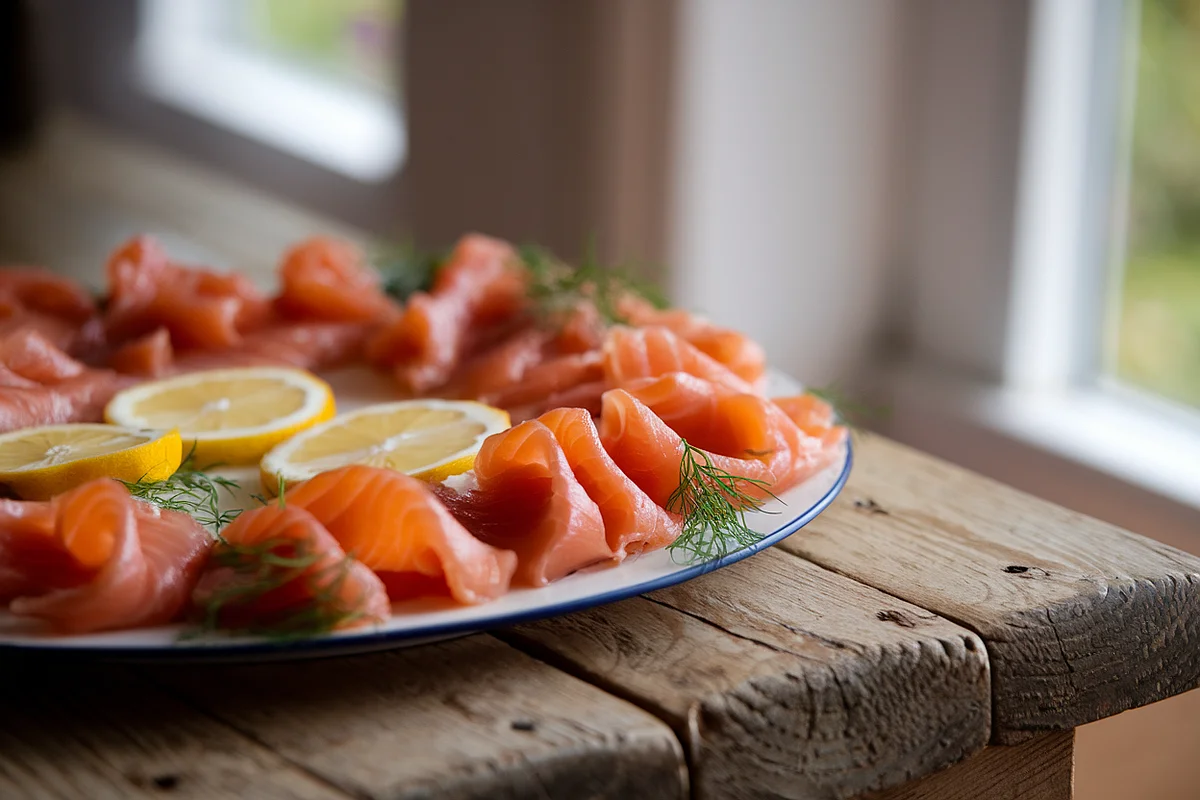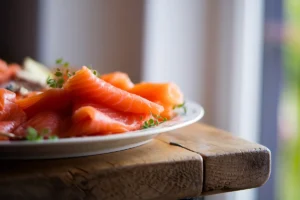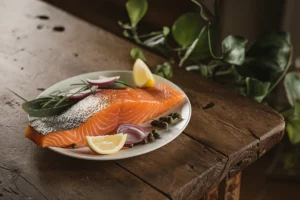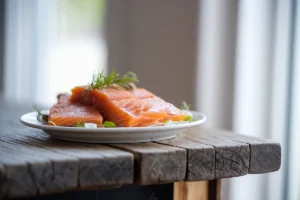Smoking salmon is a beloved culinary art, dating back centuries as a means of preserving this highly nutritious and flavorful fish. Today, smoking salmon is not just about preservation but also about creating complex, savory flavors that enhance the natural richness of the fish. But how many hours should you smoke salmon? The answer depends on various factors, such as the type of smoking method you use, the size and cut of the salmon, and personal taste preferences.
This comprehensive guide will cover everything you need to know, from brining the fish to choosing the right wood for smoking and mastering the correct smoking time. By the end, you’ll have all the tools and knowledge needed to create perfectly smoked salmon at home.
But one of the most common questions for those new to smoking fish is: How many hours should you smoke salmon? The answer to this question depends on various factors, such as the type of smoking method you use, the size and cut of the salmon, and personal taste preferences.
This comprehensive guide will cover everything you need to know, from brining the fish to choosing the right wood for smoking and mastering the correct smoking time. By the end, you’ll have all the tools and knowledge needed to create perfectly smoked salmon at home.
Types of Smoking: Hot Smoking vs. Cold Smoking
Before discussing how many hours you should smoke salmon, it’s essential to understand the two main types of smoking: hot smoking and cold smoking. Each method has its own time requirements and yields different textures and flavors.
Hot Smoking Process
Hot smoking involves cooking the fish at a higher temperature, typically between 120-225°F. The higher heat infuses the fish with smoky flavors while also cooking it through. This method results in a moist, flaky texture that’s perfect for immediate consumption.
- Smoking Time for Hot Smoking: Depending on the size of the salmon, the smoking time for hot smoking typically ranges between 1 to 6 hours. For thinner cuts like fillets, you may only need 1 to 3 hours. Larger pieces, such as whole sides of salmon, can take 4 to 6 hours.
Hot smoking is a quicker process and ensures that the salmon is fully cooked. This makes it ideal for those who want to enjoy their smoked fish right away.
Cold Smoking Process
Cold smoking, on the other hand, involves smoking the salmon at much lower temperatures, usually between 75-85°F. In this method, the fish is not cooked but rather cured and flavored with smoke over an extended period. This method gives the fish a firm, silky texture with a more intense smoky flavor.
- Smoking Time for Cold Smoking: Cold smoking is a much longer process, typically requiring between 8 to 24 hours of smoking time. The exact time depends on how smoky you want the fish and the thickness of the salmon.
Cold smoking is ideal for making lox or smoked salmon that can be served cold, usually with bagels or in salads.
Selecting the Right Salmon for Smoking
Before deciding on how long to smoke your salmon, choosing the right type of fish is crucial. Both wild salmon and farmed salmon can be smoked, but each has unique characteristics that affect the final product.
Wild vs. Farmed Salmon
- Wild Salmon: Varieties like Chinook, Sockeye, and Coho salmon are highly prized for their firm texture, deep color, and rich flavor. These types of salmon are ideal for smoking because their higher oil content makes them more flavorful and moist after smoking.
- Farmed Salmon: Farmed salmon, particularly Atlantic salmon, tends to have a higher fat content and a softer texture compared to wild salmon. While farmed salmon can still produce excellent smoked fish, the softer texture might not hold up as well during long smoking processes like cold smoking.
When choosing your salmon, always prioritize freshness. Fresh salmon should have a mild, clean smell and bright, moist flesh. For tips on choosing the freshest fish, check out this resource on How to Choose Fresh Fish for Smoking.
Brining: A Crucial Step for Perfectly Smoked Salmon
Before you begin smoking your salmon, it’s important to brine it. Brining helps the fish retain moisture during smoking and prevents it from drying out. It also enhances the flavor by infusing the fish with salt and other seasonings.
There are two primary methods of brining: wet brine and dry brine. Both methods are effective, but each offers slightly different results.
Wet Brine
- A wet brine is a solution of water, salt, and sometimes sugar or other seasonings like herbs and spices. The salmon is submerged in this solution for several hours before smoking.
- Brining Time: For a wet brine, you’ll want to brine your salmon for at least 8 hours for thinner cuts like fillets. For larger cuts, you can extend the brine time to 24 hours.
Dry Brine
- A dry brine involves rubbing the salmon with a mixture of salt and sugar, and sometimes additional spices, and allowing it to cure in the refrigerator.
- Brining Time: For dry brining, the curing time is typically between 8 to 12 hours.
Both brining methods help draw out moisture from the fish, creating a firmer texture and enhancing the flavor. This step is crucial in ensuring the salmon retains its moisture during smoking.
If you’re interested in the health benefits of salmon, especially its rich Omega-3 content, you can explore more in this article on the Benefits of Omega-3 in Salmon.
Drying the Salmon and Pellicle Formation
After brining, it’s essential to allow the salmon to dry before smoking. This process helps create a pellicle, a slightly sticky, dry surface that allows the smoke to adhere better to the fish.
Steps for Drying Salmon
- Remove the salmon from the brine and rinse it under cold water to remove excess salt.
- Pat the salmon dry with paper towels.
- Place the salmon on a wire rack in a cool, well-ventilated area, or in the refrigerator, uncovered.
- Allow the salmon to air dry for 1 to 4 hours.
A properly formed pellicle will result in a more flavorful smoked fish, as the smoke will stick better to the surface.
Optimal Smoking Time for Salmon
Now that your salmon is brined and dried, it’s time to smoke it. The optimal smoking time depends on several factors, such as the size and thickness of the salmon, the type of smoker you’re using, and the smoking method (hot or cold).
Hot Smoking Times
- Thin fillets: For fillets that are about 1 inch thick, expect a smoking time of 1 to 3 hours.
- Thicker fillets or whole sides: For thicker cuts or whole sides of salmon, smoking time will range from 4 to 6 hours.
- Internal Temperature: The key to perfectly smoked salmon is reaching an internal temperature of 145°F. Use a meat thermometer to check the internal temperature periodically during the smoking process.
Cold Smoking Times
- Cold smoking requires a significantly longer smoking time, usually between 8 to 24 hours, depending on the thickness of the fish and the intensity of smokiness desired.
- Since cold smoking doesn’t cook the fish, the internal temperature will not rise significantly, making it essential to cure the fish properly during the brining process.
Monitoring the Temperature
Temperature control is crucial when smoking salmon, especially when determining the length of smoking time.
Smoker Temperature
- For hot smoking, keep your smoker temperature between 120-225°F.
- For cold smoking, maintain the smoker temperature between 75-85°F to ensure the fish doesn’t cook but absorbs smoke flavor.
Internal Temperature
- For hot smoked salmon, the internal temperature should reach 145°F to ensure the fish is fully cooked and safe to eat.
- For cold smoked salmon, the internal temperature remains much lower, as cold smoking does not cook the fish.
Use a reliable meat thermometer to monitor the internal temperature of the fish throughout the smoking process.
Wood Selection for Smoking Salmon
The type of wood you use for smoking will greatly impact the flavor of the salmon. Different woods offer different flavor profiles, so it’s important to choose one that complements the natural richness of the salmon.
Best Wood Chips for Smoking Salmon
- Alder: Traditionally used for smoking salmon, alder wood provides a mild, slightly sweet flavor that pairs perfectly with the fish’s natural taste.
- Hickory: For those who prefer a stronger, more intense smoky flavor, hickory is an excellent choice. However, use it sparingly, as it can overpower the delicate flavor of salmon.
- Maple: Maple wood adds a subtle sweetness to the salmon, balancing the smokiness with a touch of sugar.
- Apple: Applewood imparts a light, fruity smoke that complements the natural oils in the fish.
Experiment with different types of wood to find the one that suits your taste preferences.
Common Mistakes to Avoid When Smoking Salmon
Smoking salmon requires patience and attention to detail. Avoid these common mistakes to ensure your salmon turns out perfectly:
- Over-smoking the fish: Smoking for too long or at too high a temperature can dry out the salmon and make it tough. Keep an eye on both the smoker temperature and the internal temperature of the fish.
- Using too much smoke: Adding too many wood chips can result in an overpowering smoky flavor. It’s better to add wood chips gradually throughout the smoking process.
- Skipping the pellicle formation: Drying the salmon and allowing a pellicle to form is crucial for smoke adhesion. Skipping this step will result in less flavorful fish.
- Not monitoring the internal temperature: For hot smoking, reaching the proper internal temperature of 145°F is essential to ensure the fish is safe to eat.
How to Know When Your Salmon is Ready
There are a few ways to tell when your salmon is perfectly smoked:
- Visual cues: The salmon should have a golden-brown color, and the flesh should be firm but still moist.
- Internal temperature: For hot smoked salmon, use a meat thermometer to ensure the internal temperature reaches 145°F. This is the FDA-recommended temperature for safe consumption.
- Texture: The fish should flake easily when pressed with a fork, indicating that it’s cooked through but still moist.
Storing and Serving Smoked Salmon
After you’ve smoked your salmon to perfection, proper storage is important to maintain its flavor and freshness.
Storage Tips smoke salmon
- Refrigeration: Smoked salmon can be stored in the refrigerator for up to 10 days. Ensure it’s wrapped tightly in plastic wrap or placed in an airtight container.
- Freezing: For longer storage, smoked salmon can be frozen for up to 3 months. Wrap it tightly in plastic wrap and then place it in a freezer-safe bag.
Serving Ideas
Smoked salmon is incredibly versatile and can be enjoyed in many ways:
- As a main dish: Serve hot smoked salmon alongside roasted vegetables or on top of a salad.
- As an appetizer: Thinly sliced cold smoked salmon pairs beautifully with bagels, cream cheese, capers, and onions.
- In pasta or omelets: Flake the salmon into pasta dishes or omelets for a smoky flavor boost.
FAQs
How long should I brine salmon before smoking?
Brining time depends on the thickness of the fish. For fillets, brine for at least 8 hours. For larger cuts, extend the brine time to 24 hours.
What is the best temperature for smoking salmon?
For hot smoking, maintain a temperature between 120-225°F. For cold smoking, keep the smoker between 75-85°F.
How do I keep smoked salmon moist?
Brining the salmon before smoking is essential for retaining moisture. Additionally, don’t over-smoke the fish or use too high a temperature.
Can you over-smoke salmon?
Yes, smoking the fish for too long can dry it out and give it an overly smoky flavor.
How long does smoked salmon last in the fridge?
Smoked salmon can last up to 10 days in the refrigerator if stored properly in an airtight container.
Conclusion
Smoking salmon is an art that requires patience and precision, but with the right preparation, you can achieve mouthwatering results every time. Whether you’re hot smoking for a quick meal or cold smoking for a more delicate, lox-like texture, the key is to understand the factors that affect smoking time, temperature, and flavor.
With practice, you can create perfectly smoked salmon that’s bursting with flavor and ready to enjoy in a variety of dishes. Happy smoking!



